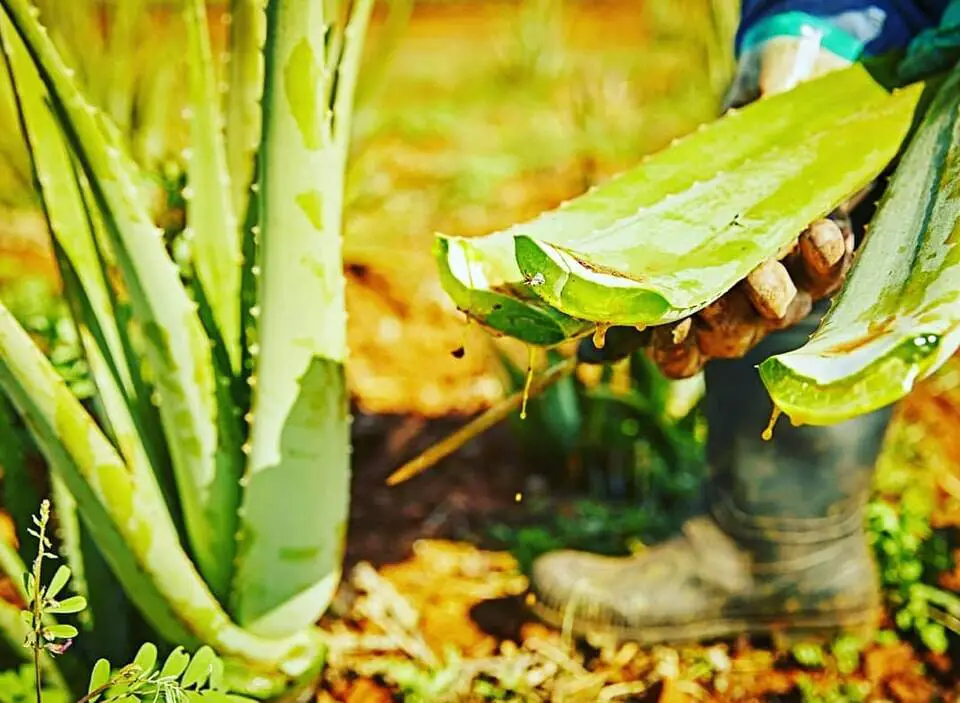Pruning your aloe vera plant is an essential part of its care routine, helping it stay healthy and grow more efficiently. Knowing how to prune an aloe vera plant properly ensures that it maintains its shape and prevents overgrowth, which can lead to weak or unhealthy leaves.
In this article, we will walk you through the steps of pruning aloe vera, from identifying when it’s time to prune to the correct techniques. Whether you’re dealing with damaged leaves or simply want to encourage new growth, proper pruning techniques will enhance the overall health of your aloe vera.

Why Trim Your Aloe Vera?
Pruning an aloe vera plant is vital for its overall health and longevity. Regularly trimming helps remove dead or damaged leaves, which can harbor pests or diseases. It also encourages better air circulation around the plant, reducing the risk of rot.
Here are some key reasons why you should prune your aloe vera:
- Promotes Healthy Growth: Removing older or damaged leaves allows the plant to focus energy on producing fresh, strong growth.
- Prevents Disease: Dead or decaying leaves can attract harmful pests or pathogens that may spread to other parts of the plant.
- Improves Appearance: Trimming helps keep your aloe vera looking neat and compact, ensuring it thrives in your garden or home.
By pruning your aloe vera plant, you support its health and aesthetic appeal, allowing it to flourish with minimal risk of complications.
Best Time to Prune Your Aloe Vera
Knowing the right time to prune your aloe vera is crucial to ensure it thrives without unnecessary stress. Aloe vera plants are resilient but pruning at the wrong time can hinder their growth. Pruning is best done during the plant’s active growing season, which is typically in the warmer months.
Here are some tips for timing your aloe vera pruning:
- Spring and Summer: This is the ideal period for pruning, as the plant is in its growth phase and can recover quickly from any cuts.
- Avoid Pruning in Winter: Aloe vera is dormant during the colder months, and pruning it at this time can lead to stunted growth or even damage the plant.
- After Flowering: If your aloe vera blooms, it’s a good idea to prune it after the flowers have faded to allow the plant to focus on rejuvenating and growing stronger.
Pruning at the right time helps your aloe vera recover faster and ensures optimal growth for the next season.
Essential Tools for Pruning Aloe Vera
To properly prune your aloe vera, you’ll need the right tools to make clean cuts and avoid causing damage to the plant. Using sharp, sterilized tools ensures that the plant isn’t exposed to harmful bacteria or disease.
Here’s what you’ll need:
- Sharp Scissors or Pruning Shears: A pair of clean, sharp scissors or pruning shears will allow you to make precise cuts without tearing the leaves.
- Sterilizing Solution: Use rubbing alcohol or a bleach solution to sterilize your tools before and after use. This prevents the spread of infections.
- Gloves: Aloe vera leaves contain a gel that can irritate the skin, so wearing gloves will help protect your hands while handling the plant.
- Tongs or a Small Spade (optional): These can help you handle larger aloe vera plants with ease, especially when removing heavy or broken leaves.
Having the proper tools ensures you prune your aloe vera safely and effectively, promoting better growth and health for the plant.
Step-by-Step Guide to Pruning Aloe Vera
Pruning your aloe vera is a straightforward process, but following the correct steps will help maintain the plant’s health and encourage new growth. Here’s how to properly prune your aloe vera:
- Inspect the Plant: Begin by examining your aloe vera for any dead, damaged, or overgrown leaves. Look for leaves that are yellow, brown, or wilted, as they should be removed.
- Prepare Your Tools: Sterilize your scissors or pruning shears with rubbing alcohol or a bleach solution to prevent the spread of disease. Make sure your tools are sharp for clean cuts.
- Make the Cuts:
- For individual leaves, cut close to the base, being careful not to damage the main stem or surrounding healthy leaves.
- If removing an entire stem, cut it near the base of the plant, leaving some space between the cut and the stem to allow for new growth.
- Remove Any Offshoots: Aloe vera produces pups or offshoots. You can trim these away to prevent overcrowding or transplant them into new pots for propagation.
- Clean Up: After pruning, dispose of any dead leaves properly. You may want to leave the plant to heal for a few days before watering again, especially if you made significant cuts.
By following these steps, your aloe vera will stay healthy, grow more vigorously, and remain an attractive addition to your garden or home.
Aftercare for Your Pruned Aloe Vera
Once you’ve finished pruning your aloe vera, it’s important to take extra care to help the plant recover and continue growing. Proper aftercare ensures that your plant remains healthy and benefits from the pruning process.
Here are some aftercare tips:
- Allow the Plant to Heal: After pruning, let the plant sit for a few days without watering. This helps the cuts dry out and form calluses, preventing rot or infection.
- Water Sparingly: Aloe vera is a drought-tolerant plant, so avoid overwatering after pruning. Water the plant lightly once it has healed, and ensure the soil is well-draining to prevent water from sitting at the base.
- Provide Adequate Sunlight: Aloe vera thrives in bright, indirect sunlight. Place your pruned plant in a sunny spot but avoid direct sunlight for the first few days to prevent stress on the fresh cuts.
- Monitor for New Growth: After pruning, you may start to see new leaves sprouting. Continue to care for your aloe vera by keeping the environment warm and ensuring it has the right balance of water and sunlight.
By following these aftercare steps, your aloe vera will recover quickly and grow back healthier, with more vibrant and robust leaves.
Common Mistakes to Avoid When Pruning Aloe Vera
Pruning aloe vera requires a delicate touch, and avoiding certain mistakes can make all the difference in maintaining the plant’s health. Here are some common pruning errors to steer clear of:
- Pruning Too Much at Once: Over-pruning can stress the plant and hinder its growth. Only remove dead or damaged leaves, and avoid cutting healthy foliage unless absolutely necessary.
- Using Dull or Unsterilized Tools: Dull scissors or pruning shears can tear the leaves instead of making clean cuts, leaving the plant vulnerable to disease. Always use sharp, sterilized tools for the job.
- Pruning During Dormancy: Aloe vera should not be pruned in winter or during its dormant period. Pruning during this time can stunt growth and cause unnecessary damage to the plant.
- Not Letting the Plant Heal: After pruning, skipping the healing process can lead to infections or rot. Always give your aloe vera time to callus over before watering.
- Cutting Too Close to the Base: When removing leaves, avoid cutting too close to the base, as this can damage the main stem and hinder future growth.
By avoiding these mistakes, you’ll ensure that your aloe vera remains healthy and continues to thrive after pruning.
Propagating Aloe Vera After Pruning
Pruning aloe vera doesn’t just improve the plant’s health—it also creates opportunities for propagation. Aloe vera produces pups (offshoots) that can be separated and replanted to grow new plants. This is a great way to expand your aloe vera collection or share with friends and family.
Here’s how to propagate aloe vera after pruning:
- Identify the Pups: After pruning, check for small offshoots or pups growing near the base of the aloe vera. These pups are genetically identical to the parent plant and can be separated for propagation.
- Separate the Pups: Gently remove the pup from the main plant by loosening the soil around it. Use a sterile knife or scissors to separate the pup, ensuring you don’t damage its roots.
- Let the Pups Heal: Just like when pruning, let the pups sit out for a few days to dry and form calluses over the cut ends. This prevents rot and promotes healthy growth.
- Replant the Pups: Once healed, plant the pups in small pots with well-draining soil. Water them lightly and keep them in a sunny, warm spot to encourage rooting and growth.
- Care for New Plants: Treat the propagated aloe vera pups just like a mature aloe plant—watering sparingly and ensuring they receive adequate sunlight.
Propagation is an excellent way to make the most out of pruning, allowing you to grow new aloe vera plants and enjoy the benefits of this hardy, low-maintenance succulent.
Using Aloe Vera in Your Home Decor
Aloe vera is not only beneficial for its health properties but also makes a stunning addition to your home decor. Its unique, spiky leaves and vibrant green color can complement various interior styles, from minimalist to bohemian. Here are some ways to incorporate aloe vera into your home:
- Stylish Planters: Choose decorative pots or containers that match your home’s aesthetic. Aloe vera looks great in sleek, modern ceramic pots, rustic wooden boxes, or even vintage teacups for a quirky touch.
- Table Centerpieces: Place a medium-sized aloe vera plant on your dining or coffee table for a natural, calming vibe. Pair it with candles or other plants to create a balanced, tranquil atmosphere.
- Windowsills or Shelves: Aloe vera thrives in bright, indirect sunlight, making it perfect for placement on windowsills or shelves where it can soak up the sun. It adds a fresh pop of green while keeping your space vibrant.
- Group Plants Together: Aloe vera pairs well with other succulents or cacti. Grouping different plants together can create a mini indoor garden, giving your space a natural, cohesive look.
Incorporating aloe vera into your home decor not only enhances the visual appeal of your space but also provides you with a functional, low-maintenance plant that’s easy to care for.
Final Thoughts
Pruning your aloe vera is an essential part of maintaining its health and encouraging new growth. By following the right steps and taking proper care afterward, your plant will thrive and continue to add beauty to your space. Remember, with the right timing, tools, and techniques, aloe vera can flourish for years to come, making it a rewarding addition to your home or garden.

I’m Shofi, a passionate gardener and blogger. I have 10+ years of experience in gardening and hold certifications in horticulture and garden design. I share my knowledge and skills through my garden blog to inspire and educate others on the joys of gardening. I try to provide valuable information and create a community for gardeners of all levels to connect and learn. My ultimate goal is to inspire others to start their own gardens and connect with nature.
